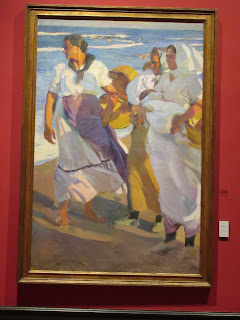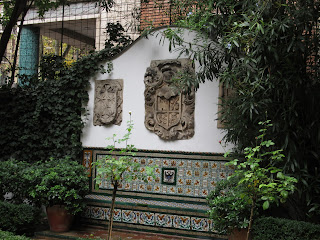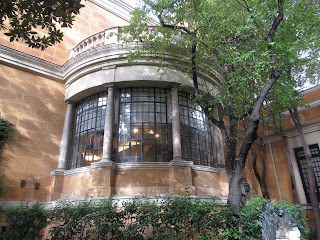After reading so many comments about people just loving the Sorolla Museum, saying it was the best in Madrid, etc, we added it to our itinerary and were curious to see what we thought of it even though neither Steven nor I had heard of the artist, Joaquín Sorolla, who lived from 1863-1923. The museum was created at the request of his widow, who donated their home and studio to the government in order to fund a museum in memory of her husband.
One of the strangest things we'd ever seen in a museum, or likely the strangest, was the museum's free Augmented Reality App where the painter came out of his paintings and explained his life and his work via a tablet we were given! Perhaps we're just way behind the times and you've seen this technology before, but it was a marvel to us.
Sorolla's art reflected the naturalistic trends of the late 19th and early 20th centuries and many specialists labeled it 'Impressionist.' But the artist considered himself closer to other painters of his day such as the Americans John Singer Sargent and James Whistler. The museum was located in Sorolla's last house in Madrid which he had built in 1911 when he was already a fully established artist. In 1909, Sorolla had traveled to New York for an exhibition of 336 works; during the month they were on display, 160,000 visited the exhibition even though it took place in February!
The polychrome carving of the Virgin and Child in the center of the room was a late 15th century sculpture from Germany. The crown was a 16th century Spanish work made of silver.
It was a treat seeing the family photo of Sorolla and his daughter with her family relaxing by the front door that we'd walked by a little earlier. Seeing the snaps made it feel like Sorolla wasn't just a famous painter but a personable one anyone could relate to.
The photo was of Sorolla on the vibrant, tiled steps to his studio in 1919. Remember this painting until further down in the post!
The painting, called White Roses, was done in 1916 and was dedicated to Clotilde on her 52nd birthday, and referred to the bouquet their son had given his mother that day. What a sweet and generous son!
The Vine Trellis depicted Sorolla's younger daughter picking grapes from a vine bathed in filtered light.
The sculptures on the writing desk were made by a great friend and protege of Sorolla.
Next post: If it's Spain, that means more churches!
Posted on January 17th, 2019, from our home in Denver's burbs!
All the beautiful gardens surrounding the home were designed by Sorolla and would have been worth the modest price of admission by themselves!
The fountain in the courtyard was decorated with Triana blue and white glazed tiles featuring geometric patterns.
The patio walls contained some of the museum's 800-piece pottery collection. We read that the style of the home was the typical Spanish setting that was popular in the late 1800s. If you've been to our home, you know I love pottery so I was quite taken with many of the pieces.
Braziers were containers that contained hot coals and were used for warmth. Some, like this one in bronze, had a cover or fireguard, a spade to remove the hot coals and four metallic feet to protect the floor from the heat. Braziers lost their practical function in the 19th century and became decorative household objects.
I had never known there were patron saints of cooks until we saw this panel from the Spanish city of Valencia which depicted Sts. Martha and Paschal Baylon and was placed in the museum in 1914.
Something else I was unfamiliar with were these trembleuses, small cups that sit inside a saucer with a central well or bracket and used for drinking hot chocolate. The former Viceroy of Peru was thought to have invented the drip saucer which could be of different shapes.
Traditionally it was customary in Spain to have 'home stoups' or 'water stoups,' containing holy water to bless oneself before entering a doorway or bedroom. Sorolla collected more than 100 stoups during his lifetime from different pottery producing areas in Spain. They were decorated with different religious themes such as the Crucifixion, the monstrance or the heraldic theme of religious orders.
His Self-Portrait was painted after his return from the exhibition in the United States which was acclaimed by both the critics and the public. The resulting unprecedented sales of his paintings ensured Sorolla's financial security and his professional future. Even though he painted it in his studio, it depicted him formally dressed rather than in working clothes, as was the norm for self-portraits.
The Horse Path is considered to be undoubtedly one of the painter's most significant canvases and also one of Sorolla's most respected and popular works. This, I read, was attributed to "the dazzling light, white hues, the shimmering skin of the horse and the beaches of Valencia."
Sorolla's commission in 1911 to decorate the library of the Hispanic Society of America - where he'd exhibited two years previously - was a decisive milestone in his life as he was charged with attempting to convey an image of Spain to the American public.
While he was immersed in his commission from the US, he spent summer breaks rediscovering his great passion: natural paintings done outside in his own country. Fisherwomen from Valencia, painted in 1915, was considered like a tribute and testimony of his admiration for these women who were both mothers and workers. Steven and I loved his paintings of people bathed in the bright light of southern Spain.
The above paintings were displayed in the room that had been used to store Sorolla's work and as a workshop where canvases and frames were prepared.
The next room was Sorolla's Office where he received customers and hung his most recently completed works so the walls were constantly changing. It was now dedicated to portraits of his family.
Ivy: The large painting of Sorolla's son reminded me right away of one you did years ago. I was wondering whether you were then familiar with Sorolla's work as it was uncannily familiar? The painting, called Mother, commemorated the birth of Sorolla's younger daughter.
The sofa still had the original silk upholstery from Sorolla's time. The style was associated with male quarters like billiard rooms and libraries.
The painting of his daughter, Elena, was just like a photo.
Sorolla was most vividly remembered in his Studio with his easels, palettes and brushes still in place. Although he preferred to paint en plein air, part of his work had to be done here with plenty of natural light from the room's windows and skylights. His sea paintings, for which he is most famous, entirely covered the walls from top to bottom just as Sorolla had them and was customary of the time.
One of the hallmarks of Sorolla's style was his ability to tackle the blinding white light of the Mediterranean summer in a way I don't recall any other artist achieving. His seascapes and beach scenes were amazing and seemed to transport me effortlessly to that area of southern Spain and time period.
The beach scenes of his family made you want to walk into their world. I could almost feel the breeze blowing at us as we stared at the paintings.
The Salon was an elegant space designed to receive guests as was customary during the second decade of the 1900s. The walnut wood seating was decorated with a block inlay or 'granadina' style - i.e. from Granada, a city we'd visit soon - which depicted Hispanic-Moorish scenes.
Bronze busts of the artist and his wife, Clotilde:
The salon had an eclectic mix of furniture, again typical of the era, including Tiffany lamps acquired during his visit to the US.
In the Dining Room, it was Sorolla, of course, who painted the garlands of fruit and vines, interspersed with portraits of his wife and daughters, that adorned the room's upper walls!
The painting, called White Roses, was done in 1916 and was dedicated to Clotilde on her 52nd birthday, and referred to the bouquet their son had given his mother that day. What a sweet and generous son!
The sculptures on the writing desk were made by a great friend and protege of Sorolla.
A painting of the artist's son, Joaquin, at the age of nineteen:
After touring his fabulous home, we explored more of the lovely gardens Sorolla designed.
The oranges were so orangey and looked just perfect to eat, I was sorely tempted to take one!
Sorolla divulged that the designs for his gardens were inspired by the Alhambra in Granada - just wait a while and you'll see why! - and the Alcazar in Seville, both of which he'd painted on numerous occasions beginning in 1908. The garden were designed to be painted, enjoyed with his family as well as a social space where he could receive clients and welcome friends. A garden for living, a garden for painting.
Standing on the steps to the studio just as Sorolla did in the photo above!
The exterior to the regal-looking salon:
As someone said, the gardens and the fountains spoke of someone who appreciated beauty and surrounded himself with it.
Though neither of us had never heard of Sorolla before visiting his home, studio and gardens, I think I speak for both of us when I say we came away big fans of his artistry. To see his masterpieces in his home, which didn't feel at all like a 'museum,' was extraordinarily special as it felt like we'd been his invited guests.
Posted on January 17th, 2019, from our home in Denver's burbs!






















































This is a great inspiring article.I am pretty much pleased with your good work. Please share good post on Study MBBS In Kyrgyzstan also. Keep it up. Keep blogging. Looking to reading your next post.
ReplyDeleteHope you also have a chance to read my many posts on our thrilling trip to Kyrgyzstan where we spent about ten days or so, part of it on a three-day horse trip in the mountains. That was an experience never to be forgotten!
ReplyDelete